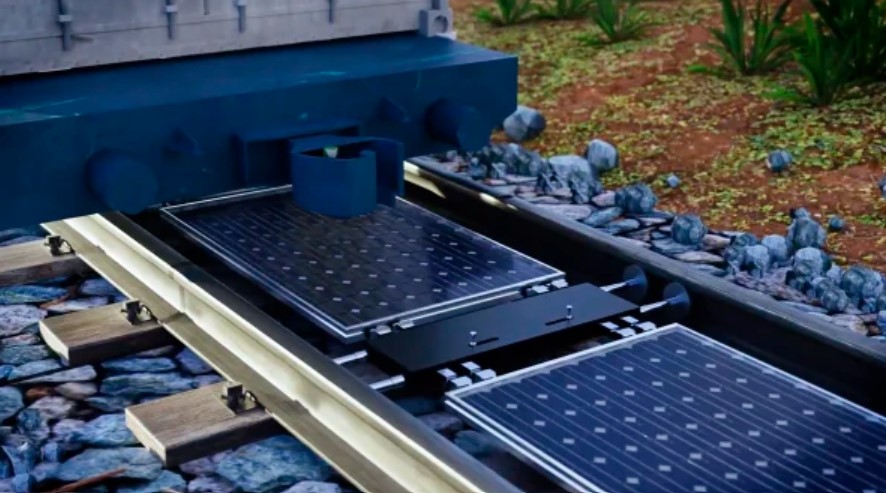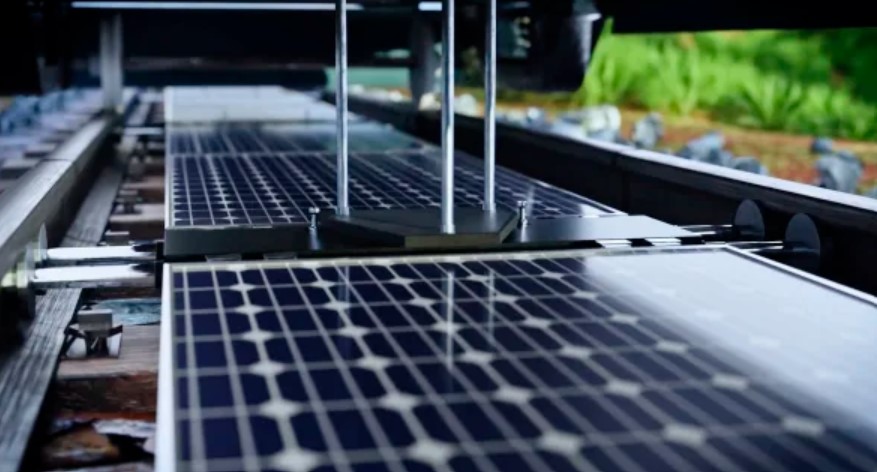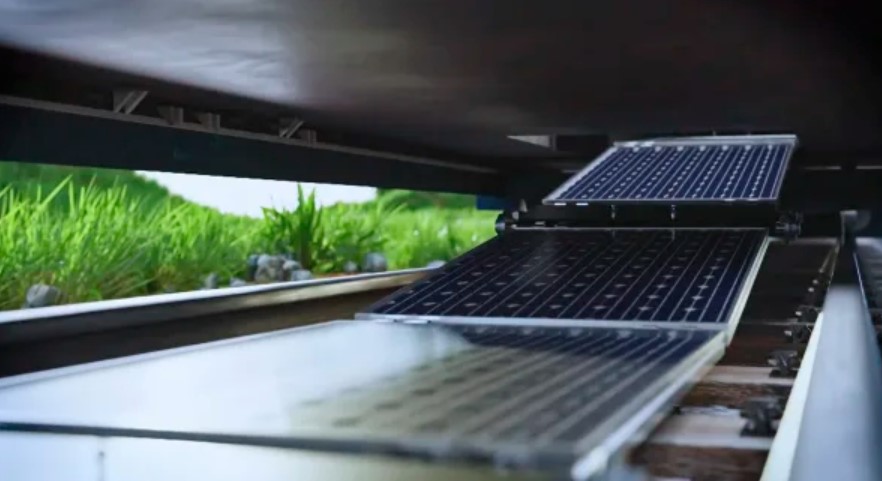Switzerland is turning the gap between train tracks into a ‘solar carpet’ with the help of a startup called Sun-Ways.
This innovative mechanism utilizes unused space between train tracks to create a long and narrow solar farm. Solar power is a vital component of achieving a clean energy future, but the visual impact and size of large-scale solar farms often face opposition from communities. In the United States alone, around 75 solar farms were rejected last year due to these concerns. To overcome this challenge, various countries have explored alternative solutions such as floating solar farms, solar panels on canals, and elevated solar panels combined with agricultural activities.
Sun-Ways, along with its competitors Greenrail in Italy and Bankset Energy in England, has devised a unique approach to solar energy generation. While the competitors use smaller panels placed on top of crossties, Sun-Ways opts for standard-size solar panels that can be installed and uninstalled using a specially designed train. This train essentially unrolls the solar panels, similar to a carpet, during the night when fewer trains are running. Sun-Ways has gained attention for its automated installation process, differentiating it from its competitors, who require manual installation.

Sun-Ways is now preparing to conduct a pilot project in Western Switzerland, with an investment of $560,000. The project, scheduled for this summer, will involve retrofitting a regular train to install approximately 60 solar panels along a 140-foot stretch near the city of Neuchâtel. The installation of these panels will transform the gap between train tracks into a reflective black ribbon, harnessing solar energy to power nearby households. The company’s founder, Joseph Scuderi, conceptualized the idea while observing the unused space between train tracks during his train commute. Baptiste Danichert, Scuderi’s co-founder, emphasizes the vast potential of utilizing this untapped space for solar energy generation.
While the concept is intriguing, there are significant challenges that Sun-Ways must address, according to Bill Nussey, the founder of the Freeing Energy Project. These challenges include debris from passing trains, the geographical distance between panels, and connecting the generated electricity to the grid. Despite these obstacles, Sun-Ways envisions a future where the electricity generated by the solar panels can be used to power the trains themselves. By implementing the solar panels on the entire 5,000-kilometer Swiss railroad network, equivalent to the current length of the Swiss rail system, 1 gigawatt of energy per year could be generated. This amount of energy would be sufficient to power approximately 750,000 homes.

Considering that there are over 1 million kilometers of railway tracks worldwide, the potential for solar energy generation is enormous, even if the system cannot be installed on every track. Moreover, the beauty of this approach lies in the fact that it does not encroach upon farmland or forests and does not disrupt natural landscapes. This innovative solution holds promise not only for Switzerland but also for other countries aiming to achieve their net-zero goals while minimizing the environmental impact.
While the initial pilot project will utilize an existing train, Sun-Ways plans to develop a custom train comprising two carriages for future installations. One carriage will store the solar panels, while the other will be responsible for the installation process. The solar panels will remain in place on the tracks indefinitely, only requiring maintenance when necessary. During maintenance, the custom train will travel over the tracks, following the same process in reverse. The utilization of a custom train is expected to significantly expedite the installation process, increasing the speed from 250 meters per hour to 1 kilometer per hour.

In the pilot program, solar panels will be installed in groups of three, securely latched between the tracks before the train stops and proceeds to load another trio of panels. Once Sun-Ways completes the development of its customized train, the company will be able to seamlessly unroll interconnected panels without the need for the train to stop.
The innovative concept of transforming the gap between train tracks into a ‘solar carpet’ demonstrates Switzerland’s commitment to green energy and innovation. Sun-Ways and its competitors are pioneering solutions that address the challenges of large-scale solar farms and offer a visually appealing alternative for communities. By utilizing existing infrastructure and untapped space, solar energy generation can be maximized without occupying valuable land or disrupting the natural landscape. As this pilot project unfolds in Switzerland, the world will be watching with anticipation to see the potential of this innovative approach and its scalability on a global scale.
Frequently Asked Questions about Solar Carpets
How does the ‘solar carpet’ concept work on train tracks?
The ‘solar carpet’ concept on train tracks involves utilizing the unused space between the tracks to create a long and narrow solar farm. Solar panels are installed along the gap between the tracks, effectively transforming it into a reflective black ribbon. This innovative approach allows for the harnessing of solar energy while minimizing the impact on surrounding areas.
What is the unique approach used by Sun-Ways for solar energy generation?
Sun-Ways, a solar energy startup, employs a unique approach to solar energy generation. Unlike its competitors who use smaller panels placed on top of crossties, Sun-Ways opts for standard-size solar panels that can be installed and uninstalled using a specially designed train. This train unrolls the solar panels, similar to a carpet, during the night when there are fewer trains running. This automated installation process sets Sun-Ways apart from its competitors, eliminating the need for manual installation.
How does Sun-Ways automate the installation process of solar panels?
Sun-Ways has developed an automated installation process for their solar panels on train tracks. Using a specially designed train, the solar panels can be unrolled along the tracks, making installation efficient and hassle-free. This automated approach significantly reduces the time and effort required for installation compared to manual methods employed by other competitors.
What challenges does Sun-Ways face in implementing the solar panel project on train tracks?
Implementing a solar panel project on train tracks presents unique challenges for Sun-Ways. One challenge is the debris that can be generated by passing trains, which needs to be addressed to ensure the efficiency and durability of the solar panels. Additionally, the geographical distance between the panels and the logistics of connecting the generated electricity to the grid pose significant challenges that Sun-Ways must overcome for successful implementation.
What is the potential energy generation capacity of the Swiss railroad network using solar panels?
By implementing solar panels on the entire 5,000-kilometer Swiss railroad network, an impressive amount of 1 gigawatt of energy per year could be generated. This energy capacity would be sufficient to power approximately 750,000 homes, highlighting the immense potential of the solar panel project on train tracks in Switzerland.
How does the solar panel project on train tracks minimize the visual impact and environmental disruption compared to traditional solar farms?
The solar panel project on train tracks offers several advantages over traditional large-scale solar farms. By utilizing the existing infrastructure and untapped space between the tracks, it eliminates the need for occupying valuable farmland or disrupting natural landscapes. This visually appealing alternative minimizes the environmental impact and addresses community concerns often associated with large-scale solar farms.
What are the advantages of utilizing unused space between train tracks for solar energy generation?
Utilizing unused space between train tracks for solar energy generation brings several advantages. It optimizes the use of existing infrastructure without encroaching upon farmland or forests. Furthermore, it maximizes the potential for solar energy generation without disrupting the natural landscape. This innovative solution offers a win-win situation by providing clean energy while minimizing the environmental footprint.
How does Sun-Ways plan to address debris from passing trains and connect the generated electricity to the grid?
Sun-Ways plans to address challenges such as debris from passing trains and connecting the generated electricity to the grid. The company will employ strategies to mitigate debris impact, ensuring the efficient and long-lasting operation of the solar panels. Additionally, Sun-Ways will establish robust electrical connections to seamlessly transfer the generated electricity to the grid, thereby enabling its integration into the existing power infrastructure.
How does the custom train developed by Sun-Ways expedite the installation process?
To expedite the installation process, Sun-Ways is developing a custom train comprising two carriages. One carriage will store the solar panels, while the other will be responsible for the installation process. This specialized train will significantly increase the installation speed from 250 meters per hour to an impressive 1 kilometer per hour, making the implementation of the solar panel project more efficient and time-saving.
What are the scalability prospects and global implications of the ‘solar carpet’ approach on train tracks?
The ‘solar carpet’ approach on train tracks holds immense scalability and global implications. With over 1 million kilometers of railway tracks worldwide, the potential for solar energy generation is enormous, even if the system cannot be installed on every track. This innovative solution aligns with the goals of various countries aiming to achieve net-zero emissions while minimizing environmental impact. The success of the pilot project in Switzerland will serve as a model for other nations seeking sustainable energy solutions, sparking global interest and potential replication of this innovative approach.
